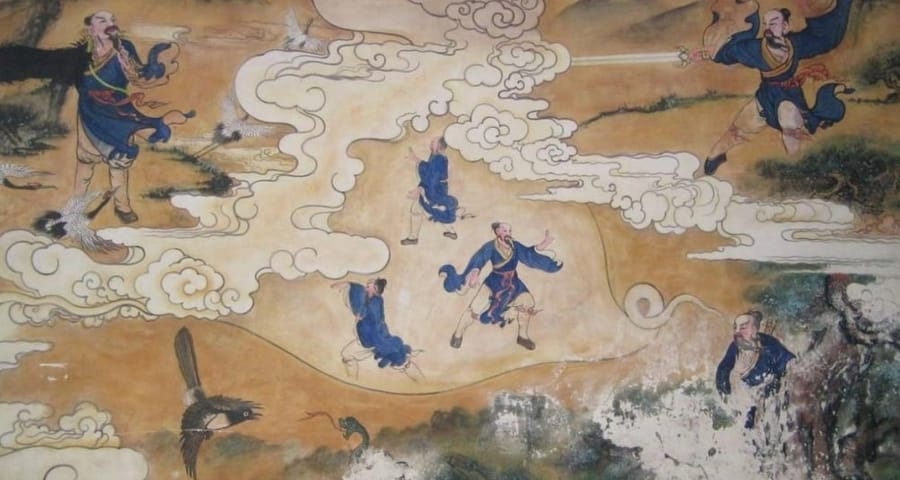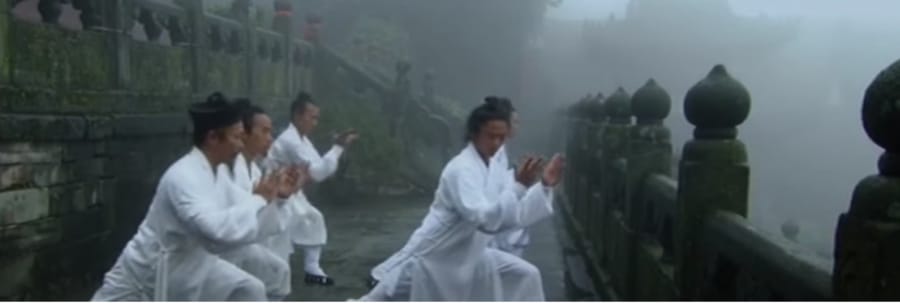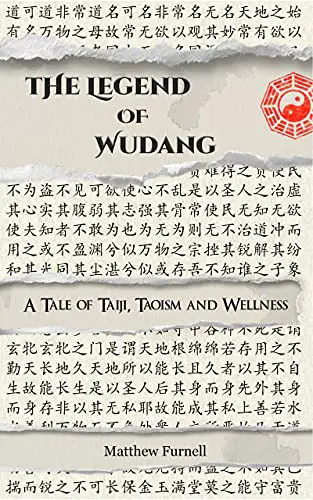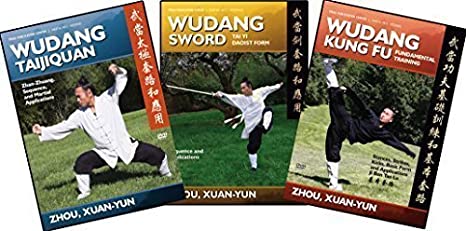There is so much debate about lineage, history, and different styles of tai chi but one thing is for clear: every practitioner and style cites a single person and a single location as the original source of tai chi. A Daoist monk in the mountains of Central China combined philosophy, meditation, and movement into what we now recognize as tai chi. And, his original sects continue to practice their own style known as Wudang tai chi.
Wudang Tai Chi is an internal martial art based on the teachings of Taoism. It originates from the Wudang Mountains where it is still practiced by Taoist sects that trace their lineage back to tai chi’s founder Zhang Sanfeng. It is unique to all other styles of tai chi because the forms are taught as part of a greater curriculum which includes Taoist study and Kung Fu.
Each style of tai chi offers us a chance to understand the art in a better way because of their focus or interest. From Chen we get martial application. From Yang we learn to open our frame into large expansive movements. From Wu we gain greater perspective on footwork and stances. What Wudang tai chi gives us is a way to see the connection between tai chi and philosophies like Daoism and Confucianism.
Videos and books on Wudang tai chi used to be hard to find but that is no longer the case with the internet, Amazon, and monks living in Wudang taking an active role in trying to preserve and spread their art.

The History of Wudang Tai Chi
Imagine you are reading “The Big Book on Everything Tai Chi.” The story of tai chi and the story of Wudang tai chi both start on page 1 in the Wudang Mountains, with a Daoist Monk named Zhang Sanfeng.
Taoist Master Zhang Sanfeng – Founder of Tai Chi
Zhang Sanfeng was born Tong JungBao (君寶 通), in south eastern China in the 13th Century. He held a government position when he was young but gave up his possessions, positions, and wealth to become a traveling ascetic. History has him traveling throughout the country. He lived among the Shaolin monks for 10 years and studying Buddhism and martial arts. Later he settled among the Taoist monks of the Wudang Mountains where he is reported to have combined philosophy with the Wudang 13 primarily martial movements to create the internal martial arts. He took his Taoist name from “three peaks” (San Feng 三丰) in China’s northwest Shaanxi Province.
There is a lot of controversy around Zheng Sanfeng’s actual life. Some doubt that Zheng Sanfeng created tai chi but instead believe his existence was embellished by later martial artists to try to legitimize tai chi in an older tradition. Some doubt his long life and instead believe Zheng Sanfeng was actually two monks of the same name combined into a single person to make his life seem grander. What is not debated is that Zhang Sanfeng gave birth to the moving philosophy of the internal martial arts which many following masters expanded upon.
It is really important to understand seven experiences or accomplishments in his life that would have given him the basis from which to “invent” a brand new form of art that is martial, spiritual, and philosophical. Zhange Sanfeng:
- Lived for a time in the Wudang Mountains among Taoist Philosophers
- Lived for a time in the Shaolin Temple studying Buddhism and external martial arts
- Was considered an “Immortal,” living an extremely long life which folklore shares was over 200 years
- Was an accomplished martial artist in the White Crane and Snake Gongfu styles
- Was an expert with the Chinese sword (jian)
- Was a highly respected Taoist master understanding the “Three Treasures” of Shen (mental focus), Qi (life-energy or breath), and Jing (physical essence),
- Was considered a master of Confucianism and Chinese literature
Did Zheng Sanfeng Create the Internal Martial Arts?
There is also some debate about whether “nejia” or the internal martial arts existed prior to Zhang Sanfeng. This is possible. However, he alone is responsible for advancing each art and philosophy individually and combining them into a moving practice that is both physical and intellectual. We’re talking about an art form that develops internal peace and martial skill at the same time.
The culmination of his travels and learning brought him to the Taoist Sects of Wudang Mountain in the later stages of his life. It is here where he formalized his theories, where much of his teachings were documented, and where his practices would be passed on for more than a dozen generations and are still being taught today.
No one knows the exact history of Wudang Tai Chi but a 1000+ year old fresco in Zixiao Palace shows Zhang Sanfeng observing a snake fighting with a magpie. This is believed to have inspired him to create Wudang kung fu with internal martial arts (nei-jia) at its core.

The Taoists of the Wudang Mountain
The Wudang Mountains have been a sacred site for Daoist practices for several centuries. It is home to palaces, temples, monasteries, and nunneries, the earliest of which date back to 600 B.C. Each successive dynasty built or rebuilt the complexes to initially gain favor and fortune from the gods but then to promote scholarly learning and philosophy to aid in their rule and campaigns. The grandeur of the history and buildings cannot be overstated and were added to the list of UNESCO world heritage sites in 1994.
What is startlingly unique about the Wudang Mountain tai chi, kung fu, and philosophy tradition is that it continues to this day! It’s not just ruins or history to be visited. You, yes you, can go their to practice and study! It is their stated goal in this modern era to openly train and teach westerners and students wanting to teach in the west so that Daoism and Wudang Mountain Tai Chi can be spread around the world.

Wudang Tai Chi
Wudang tai chi is a system based on the principles of Daoism, Confucianism, and internal development. It is unique among the styles of tai chi in that practitioners typically also study kung fu, have physical fitness regimens, and study philosophy.
As explained in an interview of 14th generation Master Zhong Yunlong:
“Wudang Tai Chi is an internal Chinese marital art referring to a martial approach focused on spiritual aspects. It focuses on harnessing human potential and cultivating skills and internal power.”
Wudang Tai Chi 中华之奇 太极武当
Unlike the focus on speed and strength of the external systems, it focuses on harnessing human potential and cultivating skills and internal power. It is most famous for it’s 13 movement form which all of tai chi is said to be based on. There is also an original long form, sword form, and many other forms that masters have added to make the form more adaptable to foreign learners.
Authentic Wudang Tai Chi
Before jumping in, let’s take a look at this beautiful art form so that we know what 15 generations of development looks like! I would also like to clear up a small misunderstanding in the martial arts community about what authentic Wudang tai chi actually is. Wudang tai chi, as the name implies, originates from and is practiced at the temples in Wudang mountain. However, there is a Wudang Tai Chi School/style that was started in the 1950s by Hong Kong practitioner Cheng Tin Hung based on Wu Family style. The school/style was named to honor the source of their tai chi but does not have direct ties to the practitioners of Wudang Mountain. Cheng Tin Hung was a notable practitioner in his own right and his England-based students have demonstrated skills. The confusion, although probably unintentional, is caused because Cheng’s students continuing to teach under the Wudang name.
Okay! Let’s set that aside and get to the good stuff.
Wudang Tai Chi Forms
What the Wudang tai chi forms share with all tai chi forms is the teaching of how to concentrate through movement while being as relaxed as possible. Movements initiate from the center or dantian, and from a martial standpoint all movements can be used as defenses or in an attack.
Like so many tai chi styles, there are different forms such as the 13, 28, 36, and of course -108. The Wudang Tai Chi 13 Form contains all of the “primordial elements” of tai chi and has the longest history of all tai chi forms. Many practitioners around the world have learned the Wudang Tai Chi short form before moving on to the longer version.
Tai Chi Wudang Short Forms
Wudang Tai Chi 13 Form Tutorial
Wudang Tai Chi 28 Form
The Wudang Tai Chi 28 step form is based on the original 108 movement long form. Many of the repetitious movements were removed so that new practitioners could memorize it more easily.
Wudang Tai Chi Long Form
The Wudang Tai Chi Long Form has 108 movements and was developed by Zheng San Feng’s disciples. It incorporates all the movements and energies from the original 13 movements and is typically taught in eight parts.
Wudang Tai Chi Sword
Often times people hear about the Wudang tai chi sword form before they learn anything about the history or lineage. Truly, all of us who practice sword look on it like a car enthusiast passing a vintage lot of automobiles. It is refined. It is beautiful. We hope we move like that some day.
The Wudang sword form, like the original tai chi open hand form, was passed down to Chen and Yang grandmasters who incorporated the form into their styles and further passed them down to next generations. I found a slow example of the Wudang sword performed from the front. Check out how perfect his posture remains, how the handle is rotated to create big, perfect circles with the blade, and how continual the movements are.
Tai Chi Books and Video Resources
This is one style where more exists as Wudang Tai Chi Youtube videos than you are able to find from teachers in this style. In a video interview of Grandmaster Zhong Yunlong, he admits as much and shared that teachings until recently were passed down verbally or were not translated. He is working to change that and standardize the Wudang content. Until then, or until you buy your ticket to travel to the Wudang Mountains, there are a couple of resources that are great.
Wudang Tai Chi Online Courses
With Master Gu you get the rare opportunity to learn tai chi directly from a Taoist master. Master Gu is a 15th generation disciple of the San Feng Pai – a tai chi family dating back to the founder of Taiji; Zhan San Feng. You’ll study the Wudang Tai Chi 8 form which is great form for beginners,
An Overview the Main Tai Chi Styles
This is part of a series of articles that we wrote on all the most popular styles of tai chi. Keep reading in that direction or find out how to improve your tai chi form.





